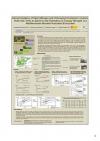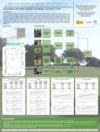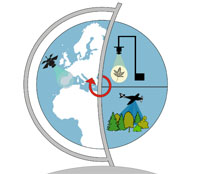Biospec Publications
| Three band indexes for nitrogen content estimation in Holm oak in a temporal scaleAmerican Geophysical Union (AGU) 2011 Fall Meeting. 5-9 December 2011 San Francisco (EE.UU) | |
| A comparison of evapotranspiration and evaporative fraction estimates using the triangle method with MSG-SEVIRI, MODIS and LANDSAT 5 TM3rd iLEAPS Science Conference Garmisch-Partenkirchen (Alemania) 18-23 Septiembre 2011 | |
| Obtención de información espectral a diversas escalas para la estimación de parámetros biofísicos de la vegetación Mediterránea en el contexto del cambio global (BIOSPEC)XIV Congreso de la Asociación Española de Teledetección Mieres (Asturias) 21-23 Septiembre 2011. | |
| Spectral measurements at flux tower sites: initial findings from the Eurospec project2011 RSPSoc Annual Conference. Bournemouth (UK) 13-15 Septiembre 2011 | |
|
|
Linking spectral information at different spatial scales with biophysical parameters of Mediterranean vegetation in the context of global change (BIOSPEC) Abstrac: Download pdf here. M. P. Martín, J. Pacheco-Labrador, A. Carrara, M. P. Echavarría, J. Gajardo, M. Gallardo, C. Gimeno, I. Gómez, R. González, F. J. Martínez, G. Mendiguren, H. Nieto, F. Pérez, D. Riaño and J. Salas FLUXNET and SpecNet Open-Workshop: Towards Upscaling Flux Information from Towers to the Globe. Berkeley, CA June 2011 |
|
|
Leaf nitrogen estimation with hyperspectral Normalized Ratio Indexes in a Mediterranean wooded grassland ecosystem OBJETIVE: Evaluate linear relationships between leaf optical response and nitrogen content (LNC) in Holm oak trees, and its coherence with nitrogen-compounds absorption features. CONCLUSIONS: Donwload pdf here. J. Pacheco-Labrador, M.R. González, M.P. Martín, D. Riaño 7th EARSeL SIG Imaging Spectroscopy workshop, Edimburgh, April 2011 |
 |
Annual Variation of Foliar Nitrogen and Chlorophyll Contents in Mature Holm Oak Trees as a Basis for the Estimation of Canopy Nitrogen in a Mediterranean Wooded Grassland Ecosystem Conclusions: - There have been found significant differences in the nitrogen concentrations between leaf age classes and also during the sampling dates. Three main periods were identified whose foliar N concentrations differed clearly: the time between sprouting and leaf elongation, the dry summer period and the wintertime. The first is characterized by a maximum of foliar N concentrations (in dry mass units, g/kg), not only related to the foliar chlorophyll contents. Water and thermal stress in summer produced a stabilization of N foliar concentrations over time and between age classes. During the fall-winter time the leaves accumulate increasingly N until the next new spring arrives. - The rate of leaf renovation in the crown is a usually unknown parameter. The time span of the year characterized by less variability over time and between leaf age classes was the dry summer period, in this study area between June and September. Therefore, average estimations of N at crown level will be less dependent of leaf renovation rate at this time of the year for evergreen species under Mediterranean climate conditions like the Quercus ilex of the study area. Download pdf here.
González Cascón, M.R., Pacheco Labrador, J., Martínez Vega F.J., Martín Isabel M.P. Nitrogen & Global Change. Key findings-future chalenges. Edinburgh, April 2011. |
 |
Multi-scale estimation of vegetation and soil moisture in a Mediterranean wooded grassland (dehesa) using optical sensors
A multi-scale and multi-temporal approach was applied to estimate vegetation water content and soil moisture in a typical Mediterranean wooded grassland (Dehesa) using remote sensing data. A field campaign to sample vegetation water content was carried out in the test site located in NE Cáceres (Spain) from March to December 2009. Soil moisture was measured using Time Domain Reflectometry (TDR) at 4, 10 and 20 cm depths. Field spectra were acquired using ASD FieldSpec® 3 spectro-radiometer. Canopy Water Content (CWC) was estimated based on the inversion of a radiative transfer model (Trombetti et al. 2008) both for field spectra as well as from MODIS Terra satellite data. Simple regressions between vegetation, soil moisture and spectral indices were carried out. NDVI and NDW7 showed the best correlation with vegetation moisture (R2=0.91 and 0.90) both from field spectra and satellite data. Correlation with soil moisture was weak for spectral indices, except for CWC estimated from MODIS data (R2 = 0.56).
Download pdf here
Gorka Mendiguren, M. Pilar Martín, David Riaño, F. Javier Martínez, Javier Pacheco, Lara Vilar Third Recent Advances in Quantitative Remote Sensing, September 2010, Valencia, Spain |

